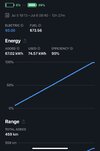Relax!View attachment 953710
Alright gang, I need some help here - I supercharged a few times month ago on a 1000kms road trip but it’s now showing I’ve lost over 10% capacity!
Haven’t charged passed 55% other than the supercharging to about 70-85%.
I’ve read this could be a BMS calibration issue so last night I charged from 6% -> 100% via Level 2 charger and this screenshot is after that charge, no recovery
Do I need to do it again or did 3 supercharging sessions toast my 82kwh battery (seems unlikely).
For starters, for once Tessie seems spot on tyhe initial capacity. (I guess per definition it acutally starts around 82kWh moslty, but is at 80.5 or so when the user get the car.)
Ususal capacity 75.3kWh doesnt seem that bad.
The line on the other hand points a bit lower.
Supercharging seem to decrease the capacity on short term, but using low SOC when not needing more seem to recover capacity. This is supported by research on the subject.
Just go 50-55% when you do not need more than that and give it a month or so, the capacity and range will most probably increase again.
Small cycles at low SOC seem to deplete som of the lithium plating caused by fast charging.
In any case, having high SOC ( > 55%) in a high temperature environment will take a bigger bite of the battery than occational supercharging.



